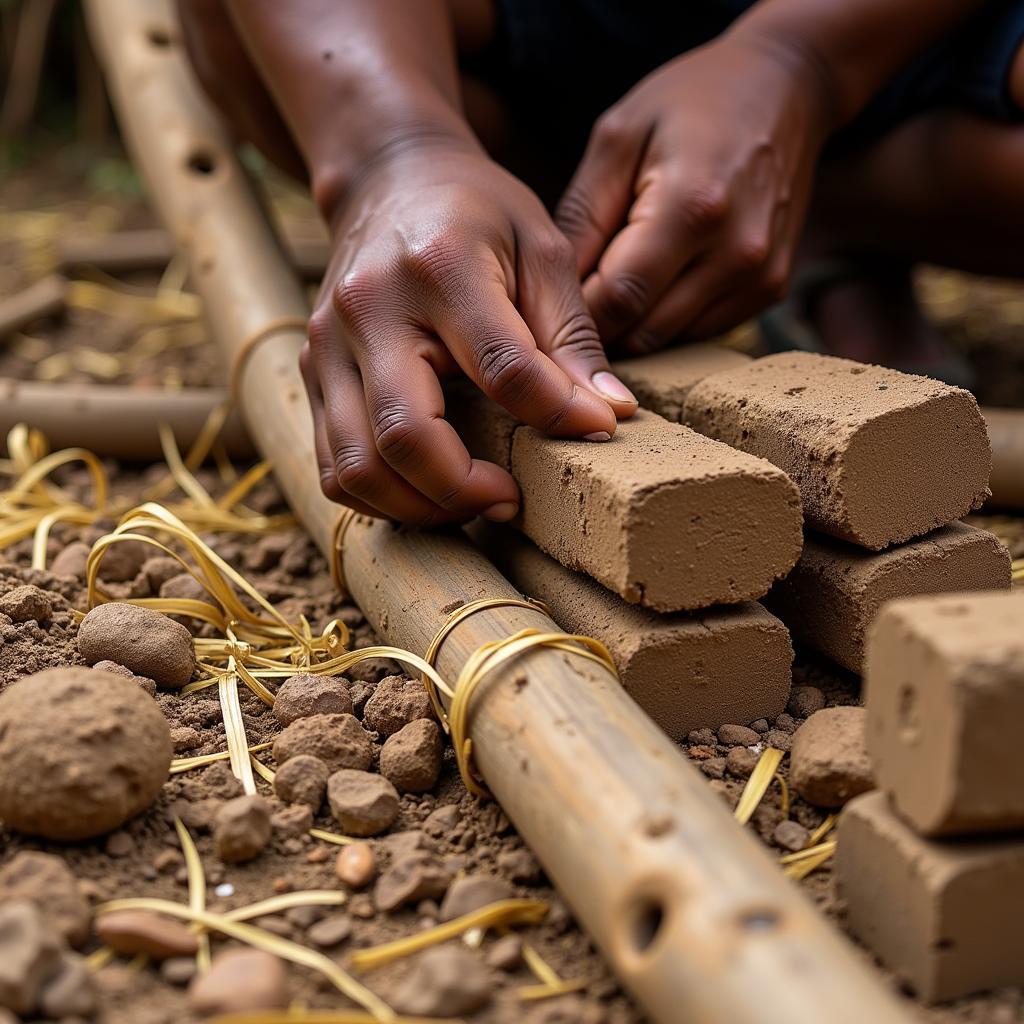Exploring the Beauty of African Huts Images
African Huts Images offer a glimpse into the diverse cultures and architectural ingenuity across the African continent. These structures, more than just shelters, reflect the resourcefulness, traditions, and artistry of the communities that build them. From the conical thatched roofs of the Maasai in East Africa to the cylindrical mud huts of West Africa, each design tells a unique story about its people and their relationship with the environment. Let’s delve deeper into the captivating world of African huts.
Diverse Architectural Styles of African Huts
The imagery of African huts is incredibly varied, showcasing a vast array of styles dictated by local climate, available materials, and cultural practices. For instance, in arid regions, you might see huts constructed from mud and straw, offering excellent insulation against the scorching sun. In contrast, communities residing in regions with abundant rainfall often favor elevated structures with steeply pitched roofs to facilitate water runoff. These architectural choices are not only practical but also aesthetically pleasing, reflecting the ingenuity and creativity of the builders. This variety is evident in available resources, such as African hut stock photos, which can provide a visual catalog of these diverse structures.
In some communities, the decorations and patterns adorning the huts also hold symbolic meanings, telling stories of ancestry, spirituality, and social status. These intricate details add another layer of richness to the already fascinating imagery. This visual journey through African architecture demonstrates the profound connection between people and their environment.
 Traditional African Mud Huts in a Rural Village
Traditional African Mud Huts in a Rural Village
What Materials Are Commonly Used in Building African Huts?
Commonly used materials include mud, straw, grass, bamboo, wood, and even recycled materials. Mud bricks, often reinforced with straw, provide excellent insulation and durability. Thatched roofs, skillfully crafted from dried grasses or reeds, offer protection from the elements. The use of local materials not only minimizes environmental impact but also contributes to the unique aesthetic qualities of each hut. You can explore more about African architecture by looking at African culture and traditions pictures.
The selection and combination of these materials are carefully considered based on their properties and availability, resulting in structures perfectly adapted to the local environment. This sustainable building practice highlights the deep respect for nature prevalent in many African cultures.
 Close-Up Detail of African Hut Construction Materials
Close-Up Detail of African Hut Construction Materials
How Do African Huts Reflect Cultural Values?
African huts often symbolize community, family, and tradition. The construction process itself can be a communal effort, strengthening social bonds and passing down traditional building techniques through generations. The interior layout often reflects social structures and hierarchies, with designated spaces for specific activities and family members. Furthermore, the decorations and symbols incorporated into the hut’s design often carry deep cultural and spiritual significance. For those interested in a dynamic portrayal of these structures, african chuts vedio may offer a valuable resource.
The shape and size of the hut can also indicate social status or family size. In some cultures, larger, more elaborate huts are reserved for community leaders or families with a long lineage. These architectural expressions provide valuable insights into the social fabric and cultural values of different African communities.
The Future of Traditional African Huts
While modernization and urbanization are influencing housing styles across Africa, there is a growing movement to preserve and celebrate traditional building techniques. Recognizing the sustainable and culturally significant nature of these structures, many communities are actively working to maintain their heritage. This includes adapting traditional designs to incorporate modern amenities while still retaining the essence and beauty of the original forms.
The continued existence of these unique architectural styles is crucial for maintaining cultural identity and promoting sustainable living practices. Images of African huts serve as a powerful reminder of the ingenuity and resilience of African cultures, and the importance of preserving these traditions for future generations.
Conclusion
African huts images are more than just picturesque representations of traditional architecture. They offer a window into the rich tapestry of cultures, traditions, and ingenuity across the African continent. From the materials used to the symbolic decorations, each detail tells a story. By appreciating and understanding the significance of these structures, we gain a deeper appreciation for the diverse heritage and sustainable practices of African communities. Exploring African huts images is a journey into the heart of Africa, a celebration of its people, and a testament to their connection with the land.
FAQ
- What is the typical lifespan of a traditional African hut? The lifespan varies depending on the materials and climate, but with proper maintenance, some huts can last for several decades.
- Are African huts still being built today? Yes, traditional huts are still being built, particularly in rural areas, and their designs are often adapted to incorporate modern needs.
- What are some of the challenges faced in preserving traditional African architecture? Challenges include urbanization, the availability of traditional materials, and the shift towards modern building practices.
- How can I learn more about specific types of African huts? Researching specific ethnic groups and their traditional architecture is a great way to delve deeper.
- Are there opportunities to experience living in a traditional African hut? Yes, some eco-tourism lodges and cultural centers offer opportunities to stay in authentic or adapted traditional huts.
- What are some of the benefits of building with natural materials? Natural materials are sustainable, often readily available, and provide excellent insulation.
- How do African huts adapt to different climates? Design features like elevated floors, steep roofs, and thick mud walls are used to adapt to different climatic conditions.
More to Explore
- Are you interested in other aspects of African culture? Learn more with these resources.
- Explore additional image galleries showcasing the diversity of African architecture.
Contact Us
For more information or assistance with your travel plans, please contact us:
Phone: +255768904061
Email: kaka.mag@gmail.com
Address: Mbarali DC Mawindi, Kangaga, Tanzania.
We have a 24/7 customer service team ready to help.


